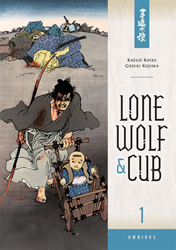Title: Lone Wolf and Cub omnibus 1
Author: Kazuo Koike, Illustrator: Goseki Kojima
Publisher: Dark Horse
If you’re a manga fan and you haven’t at least heard the name Lone Wolf and Cub, then you’ve got some research to do. Written by Kazuo Koike and illustrated by Goseki Kojima, Lone Wolf and Cub follows the story of Ogami Itto and his son, Daigoro (the Lone Wolf and the Cub, respectively), on their path for revenge.
Each story through the manga is rather simplistic and formulaic. I don’t know how it worked in 1970 when the manga was originally released (I suspect it was chapter by chapter as it is now), but the formulaic first few stories grow tiring after a while. It’d be nicer to have the flashback telling Itto’s background before getting too far into episodic stories.
The stories are steeped in realism, have unsurpassed artwork, and a historical storytelling of the Tokugawa era Japan (historical storytelling perhaps only surpassed by Akira Kurosawa himself). The setting itself steeps the reader so deeply into the Tokugawa era, that those who know nothing about the era will be fascinated by the varying settings and those who are familiar with the era will praise Koike’s storytelling. Each story brings you into a different caste, a different round table of characters, and each were unique in their backstories (albeit all had the same motivations). You’ll see the rich, the middle class, and the poor in three consecutive stories and understand each of their lives simply by how they are portrayed by Koike and why they hire the Lone Wolf and Cub.
It’s only after the chapter nine flashback that I gained a greater appreciation for what Itto is doing and what his journey is. The story shifts from enemy of the week to how Itto’s goals are furthered by the enemy; a goal that I was previously not privy to, and I believe dragged the stories down because of it. A story like chapter 11, “The Coming of the Cold,” means so much more after knowing their backstory.
My biggest reservation about Lone Wolf and Cub is that Itto seems relatively invincible. Early on, he’s never hurt and he’s never caught off guard. The stories themselves are interesting and steeped in history (of which I am a fan), but it seems unrealistic that he would never be hurt, or lose in any way. There was one particular story where he was blinded by an eagle. But that seemingly came into his master plan, because he needed to seem vulnerable to be captured. It’s a flaw of this kind of episodic storytelling, and it’s by no means the fault of Koike for taking that route. But you can’t help but think that this man is invincible. You keep waiting and waiting for that moment when he gets cut, and you know it’s going to be a huge moment. But for now, I’m merely waiting for him to win by the end of the chapter. The piece of storytelling I cling on to is what danger is Daigoro being put into in each chapter. Itto puts his son in mortal danger all to achieve his own goals. It’s reckless parenting. But the aforementioned “The Coming of the Cold” cements his love and care for his son as a mainstay in the story. It tells us that Itto cares about Daigoro on more than a father-son level.
The artwork in Lone Wolf and Cub is nigh on unmatched in anything else I’ve read. The backdrops are detailed and realistic whereas current mangaka might just draw some shapes that resemble buildings or forests. The character designs sometimes make it hard to tell who’s who, but it’s never a question of where Itto is and what he’s doing. Faces are often reused (maybe like Tezuka’s “star system”), but that’s understandable when you have so many episodic characters. There are only so many faces one artist can use and the clothing is, by period, repetitive. Clothing, however, is typically unique in the designs on them. A sign of good artwork in comics could be considered when you can just look at the art and understand the story without the text. Kojima most certainly pulls this off in the comic.
Dark Horse did choose to keep the manga “flopped” (read left to right), as when it was originally published. At the time, it was the norm for manga publishers in the US to flop their manga to make them more accessible. It wasn’t immediately evident to me, but looking back over the artwork, everyone seems to be fighting with their left hands. This may seem normal enough now, but in the Tokugawa era, warriors and samurai were taught to fight with their right hands as their dominant hands because using their left would be “wrong.” As a reader simply enjoying the story, you don’t immediately notice it, but it becomes distracting and arguably a stain on Kojima’s otherwise flawless artwork.
Also worth noting is the Frank Miller illustrated cover from its original publishing by First comics in 1987. You can immediately tell the difference between Miller’s art and that of Kojima’s. It’s my understanding that Miller’s covers helped the manga gain more popularity with Western comics readers.
Lone Wolf and Cub provides a perfect entrance for Western comics readers to Japanese comics. Dark Horse’s releases are flopped, so the reader doesn’t have to get used to reading right to left and it is THE epic comic book from Japan. Its episodic storytelling also allows anyone to pick up the story at the best chapters and not really miss anything essential.
Dark Horse is releasing the omnibuses for $19.99 MSRP, but you can find it for about $15 on Amazon. There were 28 volumes originally, so it’ll be about a nine- or 10-volume commitment, but it’ll be worth every cent.

